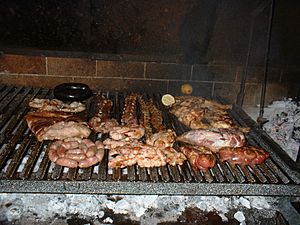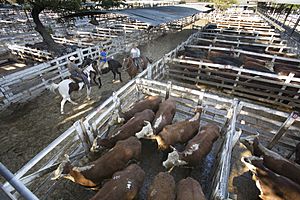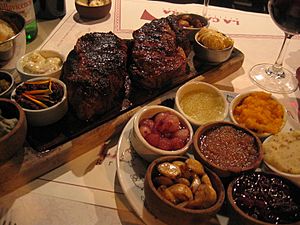Argentine beef facts for kids

Beef is a very important part of traditional Argentine food. It's a key ingredient in many popular dishes.
Contents
History of Beef in Argentina
Cattle first came to Argentina in 1536. Spanish explorers, called conquistadors, brought them. The flat, grassy lands of the Pampas were perfect for cattle. There weren't many people in Argentina back then, so the cattle grew in number very quickly.
Later, in the late 1800s, railways were built across Argentina. Also, refrigerated trains and ships were invented. This made it possible to send beef to other countries. Argentina's beef export business grew a lot. The seasons are opposite in the Northern and Southern Hemispheres. This meant Argentine beef was ready when other countries had less beef. This helped boost sales in the United States and Europe.
As more people wanted good quality beef, new types of cattle were developed. Farmers also started mixing different breeds to get even better meat.
Argentine beef and how it's produced has shaped the culture of Argentina. From the famous asado (barbecue) to the history of the gauchos (cowboys) of the Pampas, beef is everywhere. Landowners became rich from selling beef. They built big houses and important buildings. They also helped shape politics and society. The big farming show called La Rural started in 1886. It became a major social event each winter in Buenos Aires.
In Chile, there were high taxes on Argentine cattle imports in 1905. This led to protests called the meat riots. These were some of the first big protests in Santiago. The government kept meat prices high to protect local farmers. This, along with rising costs, made people very angry. The protests lasted for several days. Many people were hurt or lost their lives, and there was a lot of financial damage. This event showed that social problems were much more serious than leaders thought.
Beef Today
Argentina has one of the highest rates of beef eating in the world. Each person eats about 55 kilograms of beef every year! In 2006, there were about 50 to 55 million cattle, mostly in the fertile Pampas. Argentina is the third-largest beef exporter in the world, after Brazil and Australia.
The government adds a 15% tax on beef exports. Since March 2006, they have also put more limits on exports. This is to keep beef prices low for people living in Argentina.
On March 8, 2006, the Argentine government stopped beef exports for 180 days. They did this because beef prices inside the country had gone up by 26% that year. Later, on May 26, the ban changed to a quota. This meant only 40% of the beef exported in 2005 could be sold abroad.
These rules made cattle farmers and meat companies unhappy. Some experts said it wouldn't help in the long run and would hurt Argentina's image. Others said it was the only way to control rising prices.
In May 2021, the government again stopped beef exports for a month. This was because meat prices in Argentina were rising faster than other costs. The government wanted to control prices and make sure there was enough beef for people in Argentina. Later, they slowly allowed some exports to countries like Chile, Colombia, and Israel. They kept limits for the rest of 2021 and planned to continue them in 2022.
Foot-and-Mouth Disease Crisis
Argentina's cattle industry was a big part of its economy. The country was the fourth-largest exporter of beef. So, it was very bad news when new cases of foot-and-mouth disease (FMD) appeared in 2001. This was the first time in 60 years. FMD usually doesn't harm people, but it spreads easily between animals. This means sick animals often have to be killed. Because of this, over 60 countries, including the United States and Canada, stopped buying Argentine beef.
After a big vaccination program, the Office International des Epizooties said in 2003 that Argentina was "foot-and-mouth free with vaccination." This meant they could start exporting beef again. However, a few years later, new FMD cases were found in northern Argentina. This caused Chile to stop importing Argentine meat again.
Labelling Argentine Beef
Food safety labels are not very common in Argentina. There is no official government label. In 2003, only 35 slaughterhouses were checked and approved for good safety practices. This shows there's a need for better food safety.
However, farmers and export companies have realized that people want safer and more reliable brands. So, they have started some projects. Private groups, like cattle breed associations, give out certificates. For example, the Argentine Angus Association has a "Certified Angus Beef" label. This makes sure that only meat from an Angus cow is sold as Angus.
Other projects have also started. The "Pampas Del Salado" project puts ear tags on calves. This helps track where the meat comes from and its quality. But most of these projects don't have many participants. Labels and certificates will only become well-known if many producers join in.
Promoting Argentine Beef
To sell more beef to other countries and improve its quality, a group was formed in December 2001. It's called the Instituto de Promoción de la Carne Vacuna Argentina (IPCVA), which means the Argentine Beef Promotion Institute. The IPCVA also works to promote beef sales inside Argentina.
The IPCVA includes many people involved in beef production and export. This includes experienced cattle farmers and managers. Their wide knowledge helps the IPCVA promote beef professionally. The IPCVA is a fairly new group. It has worked to create an image for Argentine beef. This image is based on three key things: history, tradition, and prestige. These are seen as the special qualities that make Argentine beef unique.
Promoting Beef at Home and Abroad
The IPCVA has done many things to make Argentine beef more famous around the world:
- The IPCVA went to the International Food and Drink Exhibition in London in March.
- An Argentine Beef Festival was held in Helsinki, Finland, in February. A big dinner was held to promote the beef.
- IPCVA representatives went to Washington, DC. They talked about a special agreement to make it easier to send Argentine beef to North America.
- They are studying what consumers in the European Union like. This helps them create special advertising campaigns.
However, with the government's limits on beef exports, some of these efforts might not be as helpful. So, the IPCVA also focuses on promoting beef in Argentina:
- The IPCVA is creating the first map of beef eating in Argentina. This research will show where and how much beef is eaten across the country. This information will be used for marketing.
- "Las Leonas' Secret"—Las Leonas is Argentina's women's field hockey team. They have a deal with the IPCVA to eat Argentine beef. This famous sports team helps promote the meat, especially because prestige is important for Argentine beef's image.
How the IPCVA is Funded
These big promotions cost a lot of money. So, the IPCVA gets money from:
- 1.25 Argentine pesos from farmers for each animal killed.
- 0.55 Argentine pesos from meat packers for each animal packed.
This adds up to 1.80 Argentine pesos for each animal. If 13 million animals are killed each year, that's about 23,400,000 Argentine pesos. This is about €6,325,000 per year (as of March 28, 2006).
Goals of the IPCVA
The long-term goals of the IPCVA are:
- To find and create demand for Argentine beef in Argentina and other countries.
- To create marketing plans to make Argentine beef more competitive overseas.
- To plan and develop ways to help people in Argentina eat more beef.
- To work on making Argentine beef quality and safety better. This also means making farming and meat processing more efficient.
The IPCVA has become a very important tool to help Argentine beef compete better around the world.
Beef Facts and Figures
Here are some facts about Argentine beef production and exports:
| Gross domestic product of Argentina (PPP) | US$537 billion |
| Agriculture's share of GDP | 10.5% |
| Total money from beef | US$5 billion |
| Money from beef exports | US$500–700 million |
| Beef exports as a percentage of all Argentine exports | 3% |
| Percentage of worldwide beef exports | 7.36% |
| Total animals killed | 13 million per year |
| Beef produced | 2.8 million tonnes per year |
| Beef eaten per person | 55 kg per year |
Argentina produces enough beef for about two 240-gram steaks for every person in the world each year. They also have six more steaks standing on their pastures!
Beef at Home and Abroad
The high amount of beef eaten per person shows that beef is a deep part of traditional Argentine food. However, beef exports are not a huge part of Argentina's economy. This is mostly because Argentina eats most of its own beef. Also, rules and limits from other countries make it harder to export. For example, Argentina agreed with the United States to limit exports to 20,000 tons per year.
Even though beef exports haven't fully grown to contribute more to Argentina's economy, Argentina has been a big player in the world beef market for many years. This is largely because of the good reputation of Argentine beef.
From 2006 to 2015, beef exports were limited by quotas. Mauricio Macri removed these limits when he became president. The amount of beef exported then increased a lot. In 2005, Argentina could only sell about 700,000 metric tons outside the country. In 2015, only 200,000 metric tons were exported. In May 2021, the new government decided to stop exports for a month. Before this ban, Argentina had exported 933,000 tons of meat in the previous 12 months. The country slowly opened up exports again during 2021. The government suggested continuing limits in 2022.
China is the main buyer, purchasing 75% of Argentina's exported beef.
Cattle Breeds
Shorthorn
The shorthorn breed came from northeast England. It was brought to Argentina in 1826. It was the first foreign cattle breed to arrive. In Argentina, like in many other places, Shorthorns were chosen to produce both meat and milk.
Today, Argentina's Shorthorn breed has much better meat quality. This is thanks to hybridisation, which means crossbreeding with other types of cattle. This has been shown at the National Agropecuarian Technology Center.
- Characteristics: They are quite large, with wide backs and front parts. A long time ago, they sometimes looked uneven.
Hereford
The Hereford breed was developed in England. It was created to meet the growing demand for food during Britain's industrial revolution. Herefords are known for producing a lot of beef. They first came to Argentina in 1858. Their meat is known for being juicy and having a consistent flavor. Like the Shorthorn, the Argentine Hereford has also improved through crossbreeding with local cattle.
- Characteristics: High beef yield, wide back, grows quickly, good at finding food, and tough.
Aberdeen Angus
The Aberdeen Angus breed came from Scotland. Don Carlos Guerrero first brought them to Argentina in 1879. They usually do well in mild climates. Instead of crossbreeding to make them stronger, Argentine farmers focused on raising purebred Angus cattle. They made sure these cows had natural, high-quality food.
- Characteristics: Good mothers, very fertile, grow well, adapt to different climates, thin skin, and short, smooth hair.
Holando-Argentina
This breed came from the Holstein cows. They were brought from the Netherlands in 1880. They were brought to the fertile Pampas region and used for both beef and milk.
Zebu
The Zebu breed came from India. These animals are often used for pulling heavy loads. Many different Zebu breeds are found around the world. They were crossbred to pass on their ability to handle hot weather and their strength.
- Characteristics: Light colored, a clear hump between their shoulders, large horns, good tolerance for hot climates and insects.
Charolais
The Charolais breed came from Burgundy, France. They were brought to Argentina around 1910. Farmers focused on their size and strength. They paid less attention to the quality of their meat.
- Characteristics: Wide, round horns, long and tall, shoulders stick out, and deep hips.
Recipes with Argentine Beef
Beef is usually cooked over charcoal flames in Argentina. This is called an asado. It's often served as part of a bigger selection of grilled meats. People often eat it with chimichurri, a tasty sauce.
See Also
- Argentine cuisine
- Agriculture in Argentina
|




